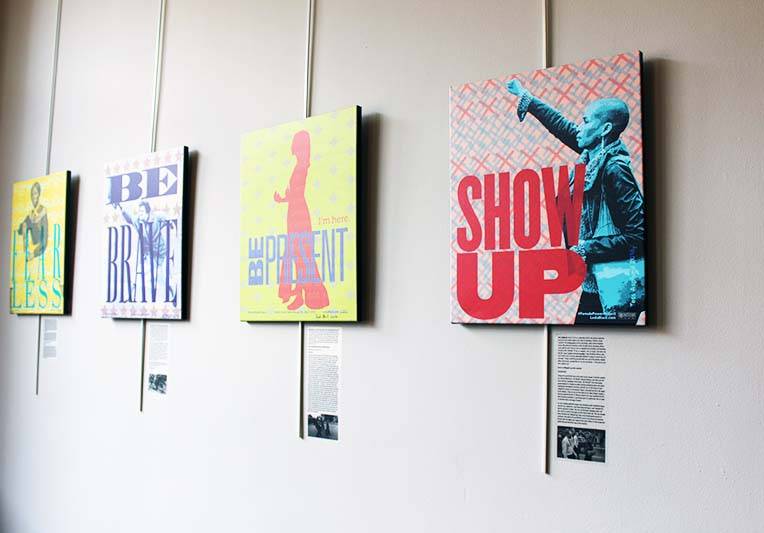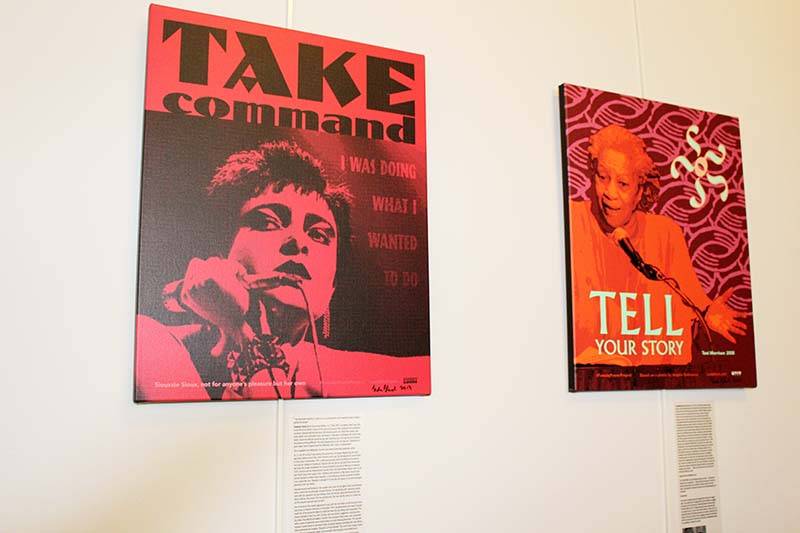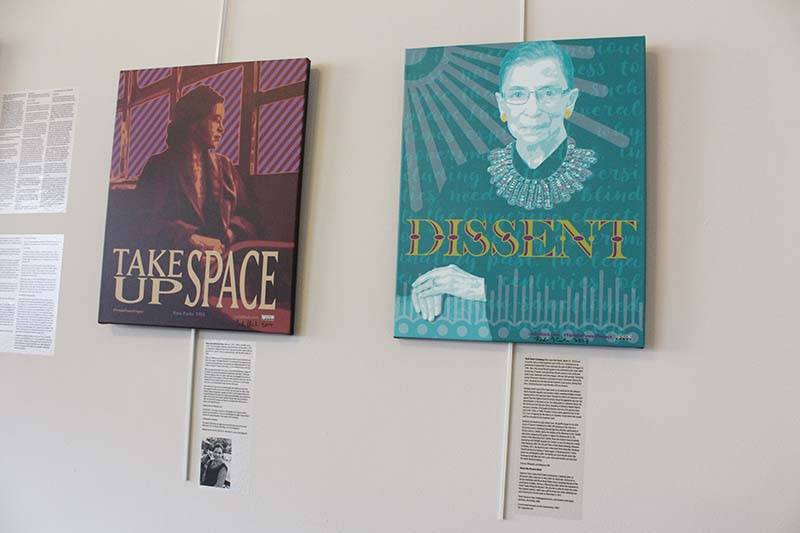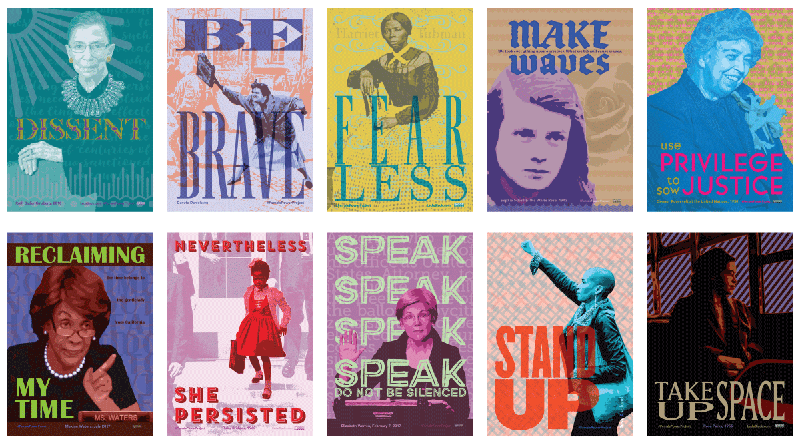Like many of us, DC-based graphic designer and visual artist Leda Black felt slapped in the face by the 2016 election and the ensuing cultural/political climate. The women’s marches she watched emerge around the globe provided her with a tonic, and a powerful dose of inspiration.
She saw that “that progressive action is becoming more potent than ever. And it is fired by female power.” Thus the Female Power Project was born. The perSISTERS portraits project is a significant piece of this initiative. Right around this time Black made the transition from employing letterpress and other analog techniques to creating digital prints. The choice to use these new tools to promote “the active powers of remarkable women,” meant she could work faster, cheaper and get her message out to more people. Black uses bolds colors, illustrated type, silhouetting and photo manipulation in a way that is reminiscent of advertising, but yet not.
PerSISTERS is more than a series of portraits. Black’s careful use of language speaks to her commitment to communication and her frustration with the limitations of rigid categories, a concern honed during her study of philosophy. Though she left the academic world behind to focus on her art, her philosophy background is clearly at work here. She writes that she has come to ”consider my art practice to be the performance of philosophy. I started out wanting to stretch language to allow meaning to expand, so that our understanding would be less limited by the rules of language.”
 Walking into the University YMCA’s Murphy Gallery (you may know it as the seating section for the Y’s famous Thai restaurant), I felt a certain cognitive dissonance between the groups of students and faculty casually chatting and the powerful portraits surrounding them. But the more time I spent in this space, the more I realized how perfect the combination was. These icons of bravery and persistence were there holding the space, waiting to inspire future thinkers and dissenters whent they were ready. They were not just art on the walls, they were a part of the conversation.
Walking into the University YMCA’s Murphy Gallery (you may know it as the seating section for the Y’s famous Thai restaurant), I felt a certain cognitive dissonance between the groups of students and faculty casually chatting and the powerful portraits surrounding them. But the more time I spent in this space, the more I realized how perfect the combination was. These icons of bravery and persistence were there holding the space, waiting to inspire future thinkers and dissenters whent they were ready. They were not just art on the walls, they were a part of the conversation.
 While each piece remains compelling in and of itself, for me, the real magic happened as I was surrounded by the exhibit. Being surrounded by the words of images of some of the bravest women in history brought on an almost visceral reaction. I felt the spark of power and possibility and hope.
While each piece remains compelling in and of itself, for me, the real magic happened as I was surrounded by the exhibit. Being surrounded by the words of images of some of the bravest women in history brought on an almost visceral reaction. I felt the spark of power and possibility and hope.
At first one notices the wide range of women included in the exhibit. Siouxsie Sious hangs proudly beside Toni Morrison. Hillary Clinton and Eleanor Roosevelt are right around the corner. Black, white, Latina, queer, straight, old, young, rich, and poor women speak both individually and as one, in an exemplary demonstration of intersectional feminism.
 In her artist statement, Black sets forth her intention to “highlight and mediate the distinctions and conflicts that arise from the limitations of human perception and understanding.” How we see her vision of these women, women whose images have been manipulated throughout history for various purposes and by various sides of the culture wars, is exactly the point. She operates according to the notion that “human minds and societies need to create differences in order to organize and structure experience — to create meaning — but these differences are subject to mental and physical limitations and are open to perversion by the exigencies of power and the forces of history.”
In her artist statement, Black sets forth her intention to “highlight and mediate the distinctions and conflicts that arise from the limitations of human perception and understanding.” How we see her vision of these women, women whose images have been manipulated throughout history for various purposes and by various sides of the culture wars, is exactly the point. She operates according to the notion that “human minds and societies need to create differences in order to organize and structure experience — to create meaning — but these differences are subject to mental and physical limitations and are open to perversion by the exigencies of power and the forces of history.”
After spending an extra moment with RBG’s “Dissent” and saying a silent prayer of thanks her for recent speedy recovery, I was stood back and began to appreciate the connections between these portraits. I began to hear an intertextual dialogue among their wide-ranging historical and cultural contexts.
What would Ruby Bridges, the first black child to integrate a New Orleans school, say to Parkland survivor and activist Emma Gonzalez? Perhaps Ruby would have hoped ours would be a more peaceful time. Maybe Emma would have told that each generation has to fight their own fights. She hadn’t thought this would be hers.
Looking across at the faces of ordinary women like Sophia Magdalena Schol, who stood up to Nazi officers, I find myself wondering what they would say to Heather Heyer, who was killed during a peaceful protest against white a supremacist in 2017.
It feels right that this exhibit should live on a college campus, where its messages are so critical. But don’t let the logistics of a visit to Campustown stop you from experiencing this powerful and provocative work.
perSISTERS: Icons from the Female Power Project
Digital Prints by Leda Black
Murphy Gallery
University YMCA
1001 Wright St
Champaign
M-F 9 a.m. to 9 p.m.
November 1st to January 15th, 2019
Learn more Leda Black at ledablack.com, or follow her on Instagram at @LedaBlackArtist
All photos by Debra Domal except top image, courtesy of Leda Black’s website.








